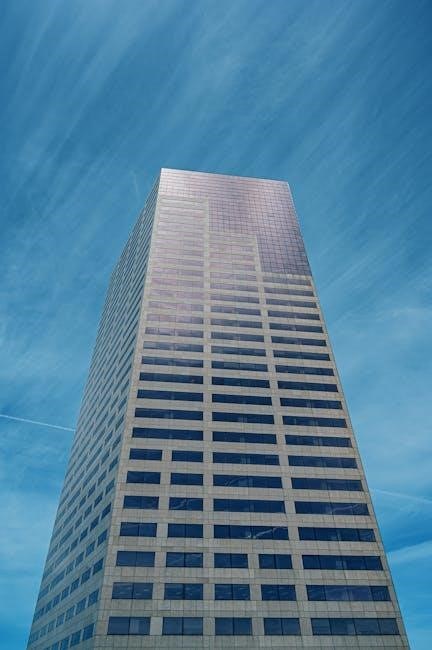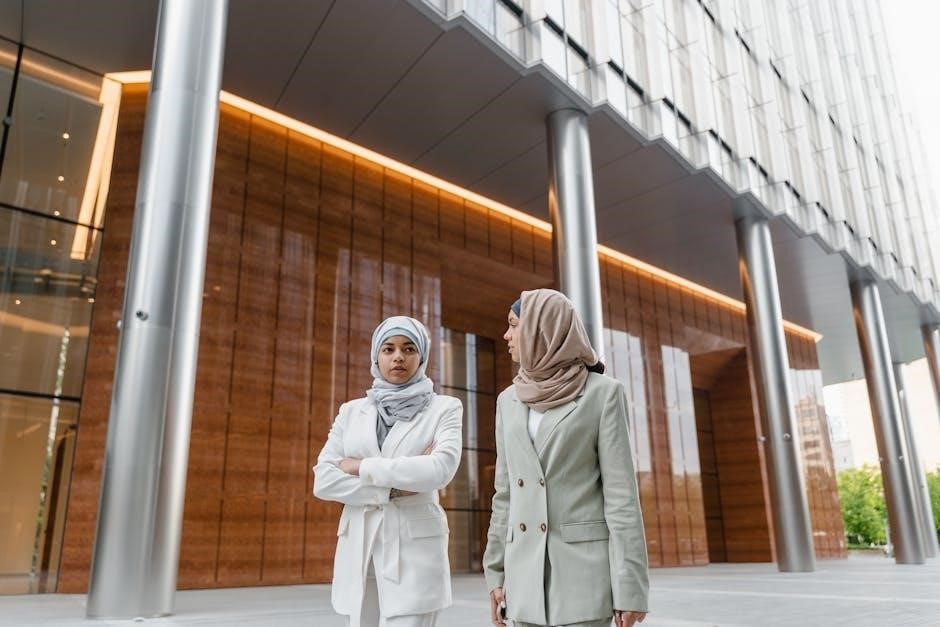The International Existing Building Code (IEBC) 2018 provides guidelines for modifying existing buildings, ensuring safety and accessibility while preserving historic integrity․ It was introduced by the International Code Council (ICC) to address unique challenges in retrofitting older structures, promoting sustainable and resilient upgrades․ The code balances prescriptive and performance-based requirements, offering flexibility for diverse building types and ages․
1․1 Overview of the IEBC 2018
The 2018 International Existing Building Code (IEBC) is a comprehensive guide for modifying and maintaining existing buildings․ Introduced by the International Code Council (ICC), it provides minimum requirements to ensure safety, accessibility, and sustainability in older structures․ The code addresses renovations, repairs, and changes in building use, offering both prescriptive and performance-based approaches․ It is part of the ICC family of codes, designed to balance modern standards with the unique challenges of retrofitting existing buildings while preserving their historic character․
1․2 Historical Development of the IEBC
The International Existing Building Code (IEBC) was first introduced in 2003 by the International Code Council (ICC) to address the unique needs of existing buildings․ It evolved from earlier codes, incorporating lessons learned and emerging technologies․ The 2018 edition builds on this foundation, introducing updated safety, accessibility, and energy efficiency standards․ Its development involved extensive collaboration with experts, ensuring it remains a critical resource for maintaining and upgrading older structures while preserving their heritage․
1․3 Scope and Application of the IEBC 2018
The IEBC 2018 applies to existing buildings, additions, and changes of occupancy, ensuring safety and accessibility․ It uses prescriptive and performance-based requirements for modifications, offering flexibility․ The code addresses historic preservation and energy efficiency, enforced by local jurisdictions․ It guides retrofitting, repairs, and upgrades, aligning with other ICC codes like the IBC and IRC․ Its scope ensures buildings remain safe, sustainable, and resilient, adapting to modern standards while respecting their heritage․

Key Changes in the 2018 Edition of the IEBC
The 2018 IEBC introduces significant updates to fire safety, accessibility, and structural requirements, enhancing safety, accessibility, and alignment with modern building codes and standards․
2․1 Updates to Fire Safety Requirements
The 2018 IEBC enhances fire safety by updating standards for fire-resistant materials, emergency lighting, and fire alarm systems․ New provisions mandate modernized exit signage and improved means of egress, ensuring safer evacuation routes․ Additionally, the code strengthens requirements for fire suppression systems in high-risk areas and clarifies retrofitting guidelines for historic buildings․ These updates aim to minimize fire hazards while balancing the preservation of existing structures, ensuring occupant safety without compromising architectural integrity․
2․2 Revised Accessibility Standards
The 2018 IEBC includes updated accessibility standards to ensure equitable access for all users․ Key revisions align with ICC A117․1 guidelines, expanding requirements for tactile signage, wheelchair ramps, and accessible restrooms․ Provisions for historic buildings now allow alternative solutions to maintain architectural integrity while meeting accessibility goals․ These changes aim to create more inclusive environments without compromising safety or structural integrity, reflecting a commitment to universal design principles in existing buildings․
2․3 Enhanced Structural Requirements for Existing Buildings
The 2018 IEBC strengthens structural requirements for existing buildings, focusing on seismic retrofitting and load-bearing capacity․ Updates include detailed evaluation processes for assessing structural integrity and new methods for retrofitting to enhance stability․ Provisions address issues like foundation adequacy and wall reinforcement, ensuring buildings can withstand natural disasters․ These changes aim to improve safety and extend the lifespan of existing structures while maintaining cost-effectiveness and minimizing disruptions during upgrades․
Structure and Organization of the IEBC 2018
The IEBC 2018 is divided into chapters, each addressing specific aspects of existing buildings, including fire safety, accessibility, and structural requirements․ It references key standards and provides appendices for additional guidance, ensuring a comprehensive framework for retrofitting and upgrading existing structures effectively․
3․1 Chapter-by-Chapter Breakdown
The IEBC 2018 is structured into chapters that systematically address various aspects of existing buildings․ Chapter 1 introduces the code’s purpose and scope․ Chapter 2 focuses on compliance requirements, while Chapter 3 delves into fire safety provisions․ Chapter 4 covers accessibility standards, and Chapter 5 details structural requirements․ Subsequent chapters address energy efficiency, legal frameworks, and practical applications, providing a detailed roadmap for ensuring safety, accessibility, and sustainability in existing structures through clear and organized guidance․
3․2 Reference Standards and Codes
The IEBC 2018 references numerous standards and codes to ensure compliance and safety․ It incorporates guidelines from the ICC A117․1 for accessibility and fire safety provisions from the International Fire Code․ Additionally, it aligns with the International Building Code for structural integrity and energy efficiency standards․ These references provide a comprehensive framework for upgrading existing buildings while maintaining consistency with other ICC codes, ensuring a cohesive approach to safety, accessibility, and sustainability in retrofitting projects․
3․3 Appendices and Supplementary Materials
The IEBC 2018 includes extensive appendices and supplementary materials to aid in its application․ These resources provide detailed guidelines for specific scenarios, such as seismic retrofitting and historic building modifications․ They also offer calculation methods and examples to clarify complex requirements․ Supplementary materials include forms, checklists, and reference tables to assist users in ensuring compliance․ These appendices are invaluable for architects, engineers, and code officials, offering practical tools to facilitate effective implementation of the code’s provisions․

Compliance Requirements
The IEBC 2018 mandates adherence to specific provisions ensuring safety, accessibility, and structural integrity in existing buildings․ Compliance involves inspections, testing, and documentation to verify conformity with code standards․
4․1 Mandatory vs․ Optional Provisions
The IEBC 2018 distinguishes between mandatory and optional provisions, ensuring clarity in compliance․ Mandatory requirements are non-negotiable, focusing on critical safety, accessibility, and structural integrity․ Optional provisions offer flexibility, allowing adaptations based on specific building conditions or local regulations․ This dual approach balances strict safety standards with practicality, enabling building owners to meet code requirements while addressing unique challenges․ Authorities having jurisdiction enforce mandatory provisions, while optional ones may be adopted based on project needs and regulatory discretion․
4․2 Inspection and Testing Requirements
The IEBC 2018 mandates regular inspections and testing to ensure compliance with safety and structural standards․ Inspections are conducted by qualified professionals to assess building conditions, identify hazards, and verify compliance․ Testing includes evaluations of fire safety systems, structural components, and accessibility features․ Documentation of findings is required, with corrective actions mandated for non-compliant elements․ These requirements ensure ongoing safety and functionality of existing buildings, addressing potential risks proactively while maintaining regulatory standards․
4․3 Documentation and Record-Keeping
The IEBC 2018 emphasizes the importance of maintaining comprehensive documentation for all inspections, tests, and modifications․ Detailed records must include inspection reports, test results, and compliance certificates․ These documents serve as proof of adherence to code requirements and are essential for tracking building modifications over time․ Authorities may request these records during inspections or permit applications to verify compliance․ Proper documentation also aids in identifying potential issues early, ensuring ongoing safety and regulatory adherence․ Accurate record-keeping is a critical component of building maintenance and code compliance․
Fire Safety Provisions
The IEBC 2018 outlines fire safety measures, including fire-resistant materials, egress routes, and suppression systems․ Updates enhance protection while maintaining building functionality and accessibility for occupants․
5․1 Fire-Resistant Materials and Systems
The IEBC 2018 emphasizes the use of fire-resistant materials and systems to enhance safety in existing buildings․ These materials must meet specific testing protocols, such as those outlined in ASTM standards, to ensure they can withstand fire exposure․ The code provides detailed requirements for fire-resistance-rated assemblies, including walls, floors, and roofs․ Additionally, it addresses the application of fire-resistant coatings and penetrations in fire-rated construction․ Compliance with these provisions helps maintain structural integrity during fires, safeguarding occupants and property․ Regular inspections and updates are mandated to ensure ongoing effectiveness․
5․2 Means of Egress in Existing Buildings
The IEBC 2018 ensures safe and accessible means of egress in existing buildings, balancing historic preservation with modern safety standards․ It mandates minimum requirements for exit widths, signage, and emergency lighting․ The code allows flexibility for retrofits while maintaining the integrity of historic structures․ Regular inspections are required to verify compliance, ensuring that exit routes remain unobstructed and accessible․ These provisions aim to protect occupants by providing clear, safe pathways during emergencies, without compromising the building’s original character or historical significance․
5․3 Fire Alarm and Suppression Systems
The IEBC 2018 mandates that existing buildings must have fire alarm systems with smoke detectors and audible alarms, ensuring timely evacuation․ Manual pull stations are required in certain occupancies․ Fire suppression systems, such as sprinklers, must be retrofitted in high-risk areas like commercial spaces․ Compliance with NFPA standards is essential․ The code allows phased implementation to minimize disruptions, ensuring safety without compromising building operations․ Regular inspections and testing are required to maintain system reliability and effectiveness in emergencies․

Accessibility Standards
The IEBC 2018 ensures existing buildings meet accessibility requirements, aligning with ICC A117․1 standards․ It mandates modifications like ramps, elevators, and clear navigation for people with disabilities, promoting inclusivity and safety․
6․1 Compliance with ICC A117․1 Standards
The IEBC 2018 requires existing buildings to comply with ICC A117․1 standards, ensuring accessibility for all users․ Key features include ramps, elevators, and clear signage․ These standards mandate minimum requirements for elements like door widths, grab bars, and accessible routes․ Compliance ensures equitable access, promoting inclusivity and safety for individuals with disabilities․ The code provides detailed guidelines for modifications during renovations or alterations, making existing buildings more usable for everyone․ Proper implementation of these standards is essential for meeting legal and ethical accessibility goals․
6․2 Modifications for Existing Buildings
The IEBC 2018 provides guidelines for modifications to existing buildings, ensuring they meet modern safety and accessibility standards while preserving their historic character․ Modifications must comply with specific requirements, balancing retrofits with the building’s original design․ The code allows for flexibility, enabling upgrades without full compliance to new construction standards․ Key areas include structural integrity, fire safety, and accessibility improvements․ These provisions ensure existing buildings remain safe, functional, and adaptable for future use, aligning with the code’s goal of sustainable and resilient structures․
6․3 Special Provisions for Historic Buildings
The IEBC 2018 includes special provisions for historic buildings, recognizing their cultural and architectural significance․ These provisions allow for flexibility in applying modern codes while preserving historic integrity․ Requirements focus on maintaining original materials, minimizing alterations, and ensuring safety without compromising historical features․ The code encourages adaptive reuse and provides exemptions for certain upgrades, such as retaining original stairways or finishes, provided they meet minimum safety standards․ This approach balances preservation with modern accessibility and fire safety needs, ensuring historic buildings remain functional and safe for future generations․

Structural Requirements
The IEBC 2018 outlines structural requirements for existing buildings, focusing on evaluation, retrofitting, and ensuring stability․ It addresses load-bearing capacity and compliance with seismic standards to enhance safety․
7․1 Evaluation and Retrofitting of Existing Structures
The IEBC 2018 provides detailed guidelines for evaluating and retrofitting existing structures to ensure safety and compliance․ It emphasizes the importance of thorough inspections, structural assessments, and performance-based approaches to determine the need for upgrades․ Retrofitting measures, such as seismic strengthening and load-bearing capacity improvements, are outlined to enhance resilience without compromising the building’s original integrity․ The code encourages cost-effective solutions while maintaining historical significance, ensuring existing buildings meet modern safety standards․ This section is crucial for engineers and architects working on retrofits․
7․2 Seismic Retrofitting Requirements
The IEBC 2018 outlines specific requirements for seismic retrofitting to enhance the resilience of existing buildings in earthquake-prone areas․ It mandates structural evaluations and upgrades to ensure buildings can withstand seismic forces․ Retrofitting techniques, such as bracing and foundation reinforcement, are detailed to improve stability․ The code emphasizes compliance with current standards to minimize risks during earthquakes․ These provisions are critical for safeguarding occupants and extending the lifecycle of existing structures in seismically active regions․ Retrofits must be tailored to the building’s unique conditions and construction materials․ Compliance ensures safety and resilience․
7․3 Load-Bearing Capacity and Stability
The IEBC 2018 emphasizes evaluating and ensuring the load-bearing capacity and stability of existing buildings․ It requires structural assessments to verify that buildings can safely support design loads without compromising integrity․ Upgrades may be necessary to meet current standards, especially in areas prone to earthquakes or high winds․ The code provides guidelines for reinforcing elements to maintain stability and prevent failure under stress․ Compliance ensures buildings remain structurally sound and safe for occupancy, aligning with modern engineering practices and safety protocols․ Regular inspections and analyses are mandated to uphold these critical requirements․

Energy Efficiency in Existing Buildings
The IEBC 2018 promotes energy efficiency in existing buildings through retrofitting and upgrading to meet modern standards, reducing energy consumption and environmental impact․
8․1 Energy Retrofit Requirements
The IEBC 2018 outlines specific energy retrofit requirements for existing buildings, ensuring upgrades meet modern efficiency standards․ These requirements address HVAC systems, insulation, and window replacements, aligning with ASHRAE and IECC standards․ The code provides flexible approaches to retrofitting, balancing cost and performance․ Energy efficiency measures aim to reduce consumption and environmental impact while maintaining building functionality․ Compliance is verified through inspections and documentation, ensuring sustainable upgrades that support long-term energy goals․ Retrofitting existing buildings is crucial for achieving broader energy efficiency objectives․
8․2 Compliance with Energy Codes
The IEBC 2018 requires existing buildings to comply with energy codes during retrofits, ensuring alignment with current efficiency standards․ Compliance is achieved through inspections, documentation, and adherence to ASHRAE and IECC standards․ The code integrates energy efficiency measures with structural upgrades, promoting sustainable practices․ By meeting these requirements, buildings reduce energy consumption and environmental impact while improving occupant comfort․ Compliance verification ensures that upgrades align with both safety and energy efficiency goals, supporting the broader objective of creating sustainable built environments․
8․3 Incentives for Energy-Efficient Upgrades
The IEBC 2018 encourages energy-efficient upgrades by offering incentives such as tax credits, rebates, and grants․ These incentives aim to offset costs for building owners who implement energy-saving measures․ Governments and organizations provide financial support to promote sustainability and reduce energy consumption․ Additionally, upgraded buildings often see reduced utility costs and enhanced property value․ These incentives align with broader goals of environmental conservation and encourage compliance with energy codes, making sustainable upgrades more accessible and economically viable for existing buildings․

Legal and Regulatory Framework
The IEBC 2018 is enforced by local jurisdictions, ensuring compliance with safety, accessibility, and energy standards․ Non-compliance may result in penalties, while incentives encourage voluntary upgrades․
9․1 Enforcement and Jurisdiction
The IEBC 2018 is enforced by local jurisdictions, with building departments responsible for inspections, permits, and compliance reviews․ Authorities ensure adherence to safety, accessibility, and structural standards․ Penalties for non-compliance may include fines or legal action․ Jurisdictional powers allow local governments to adapt code requirements to regional needs while maintaining the ICC’s baseline standards․ This dual approach ensures uniformity and flexibility in enforcing the code across different areas․
9․2 Legal Implications of Non-Compliance
Non-compliance with the IEBC 2018 can lead to legal consequences, including fines, penalties, and potential lawsuits․ Building owners may face liability for safety hazards or accessibility violations․ Courts may impose corrective actions or monetary damages․ Additionally, non-compliance can result in loss of occupancy permits, halting operations until deficiencies are addressed․ Legal repercussions emphasize the importance of adhering to code requirements to avoid financial and operational risks․
9․3 Role of Local Authorities
Local authorities play a crucial role in enforcing the IEBC 2018, ensuring compliance through inspections, permits, and approvals․ They interpret code requirements, address compliance challenges, and provide guidance to building owners and designers; Local jurisdictions may adopt or amend the code to suit regional needs while maintaining its core safety and accessibility standards․ Effective enforcement by local authorities is essential for maintaining public safety, facilitating upgrades, and preserving the integrity of existing buildings within their jurisdictions․

Case Studies and Practical Applications
Case studies highlight successful retrofits and upgrades, demonstrating the practical application of the IEBC 2018 in real-world scenarios, such as historic building restorations and school modernizations․
10․1 Successful Retrofits and Upgrades
The IEBC 2018 has enabled numerous successful retrofits, such as the restoration of historic buildings and the modernization of schools․ These projects demonstrate how the code’s guidelines for fire safety, accessibility, and structural integrity can be effectively applied․ For instance, historic buildings have been upgraded with modern systems while preserving their original character․ Schools have been retrofitted to meet current seismic and accessibility standards, ensuring safer learning environments․ These case studies highlight the code’s flexibility and its role in achieving sustainable and resilient upgrades without compromising a building’s heritage․ They also showcase the benefits of performance-based approaches, offering practical insights for future projects․
10․2 Lessons Learned from Previous Editions
The 2018 IEBC incorporates lessons from earlier editions, such as the 2015 version, which emphasized compatibility with international codes․ Previous editions highlighted the need for clearer retrofitting guidelines and more flexible accessibility standards․ Feedback from users and real-world challenges led to improvements in fire safety measures and structural assessments․ These lessons informed the 2018 updates, ensuring the code better addresses the complexities of existing buildings while maintaining safety, sustainability, and functionality․ This evolution reflects the ICC’s commitment to adapting to industry needs and advancements․
10․3 Real-World Challenges and Solutions
Implementing the 2018 IEBC often involves challenges like retrofitting older buildings to meet modern safety standards while preserving historic integrity․ A common issue is balancing accessibility modifications with structural limitations․ Solutions include using the code’s flexible guidelines for fire safety upgrades and seismic retrofitting․ Additionally, the code provides pathways for addressing unique conditions in historic buildings, ensuring compliance without compromising their cultural value․ These practical approaches help bridge the gap between preservation and modern safety requirements effectively․

Resources for Further Study
The IEBC 2018 is supported by the ICC’s official guidelines, online training, and certification programs․ Industry forums offer practical insights and discussions on code updates․
11․1 ICC Publications and Guidelines
The International Code Council (ICC) provides comprehensive resources, including the 2018 I-Codes and the IEBC 2018 in digital and print formats․ The ICC Digital Codes platform offers free and premium access to the codes, enabling users to navigate and customize content․ Key publications include the International Existing Building Code and reference standards like ICC A117․1․ These resources are essential for architects, contractors, and code officials to ensure compliance and understanding of the regulations․ Additional guidelines and interpretations are available through ICC’s official website and training materials․
11․2 Online Training and Certification
The International Code Council (ICC) offers online training and certification programs to help professionals master the 2018 International Existing Building Code (IEBC)․ These courses provide in-depth knowledge of code requirements, inspections, and compliance strategies․ The ICC Digital Codes platform includes interactive tools and resources for self-paced learning․ Certifications are available for code officials, contractors, and architects, ensuring expertise in applying the IEBC 2018 effectively․ These programs are accessible worldwide, promoting consistent and high-quality implementations of the code standards․
11․3 Industry Associations and Forums
Industry associations and forums play a crucial role in supporting professionals working with the 2018 International Existing Building Code (IEBC)․ The International Code Council (ICC) provides resources like the 2018 I-Codes and premiumACCESS, offering comprehensive guidelines and updates․ Professional organizations, such as the National Institute of Building Sciences (NIBS) and American Society of Civil Engineers (ASCE), host forums and workshops to discuss code implementation․ These platforms foster collaboration, ensuring professionals stay informed and compliant with the latest standards and best practices in building safety and sustainability․
The 2018 International Existing Building Code (IEBC) is a vital resource for ensuring safe, accessible, and sustainable upgrades to existing buildings, fostering compliance and future advancements․
12․1 Importance of the IEBC 2018
The 2018 International Existing Building Code (IEBC) is crucial for safeguarding public health and safety by providing comprehensive guidelines for modifying existing buildings․ It ensures structures remain safe, accessible, and energy-efficient while addressing historical preservation․ The IEBC 2018 bridges gaps between old and new construction, offering solutions for retrofitting and maintaining buildings, thus supporting sustainable development and community resilience․ Its adoption is essential for jurisdictions aiming to uphold modern safety standards while respecting architectural heritage․
12․2 Future Developments in Building Codes
Future developments in building codes, including updates to the IEBC, will focus on emerging technologies, climate resilience, and enhanced sustainability․ Anticipated changes include stricter energy-efficiency standards, integration of renewable energy systems, and improved seismic retrofitting guidelines․ Additionally, codes may incorporate advanced materials and smarter building systems to address global challenges like climate change․ These updates aim to ensure buildings are safer, more adaptable, and environmentally friendly, aligning with global sustainability goals and technological advancements․
12․3 Encouraging Adoption and Compliance
Encouraging adoption and compliance with the IEBC 2018 involves education, incentives, and support for stakeholders․ Training programs, workshops, and certifications help professionals understand updates․ Financial incentives, such as tax breaks or grants, can motivate building owners to implement code requirements․ Public awareness campaigns highlight the benefits of compliance, including improved safety and sustainability․ Streamlining compliance processes and providing accessible resources also facilitate adherence, ensuring buildings meet modern standards while respecting their historic character․

References
Key resources for understanding the IEBC 2018 include ICC publications, such as the 2018 International Existing Building Code and supplementary guidelines․ Online training materials, like ICC’s premiumACCESS, offer detailed insights․ Additionally, industry forums and associations provide practical discussions and case studies․ These references ensure comprehensive understanding and compliance with the code’s requirements for existing buildings, promoting safety, accessibility, and sustainability in retrofitting and maintenance projects․

Be First to Comment